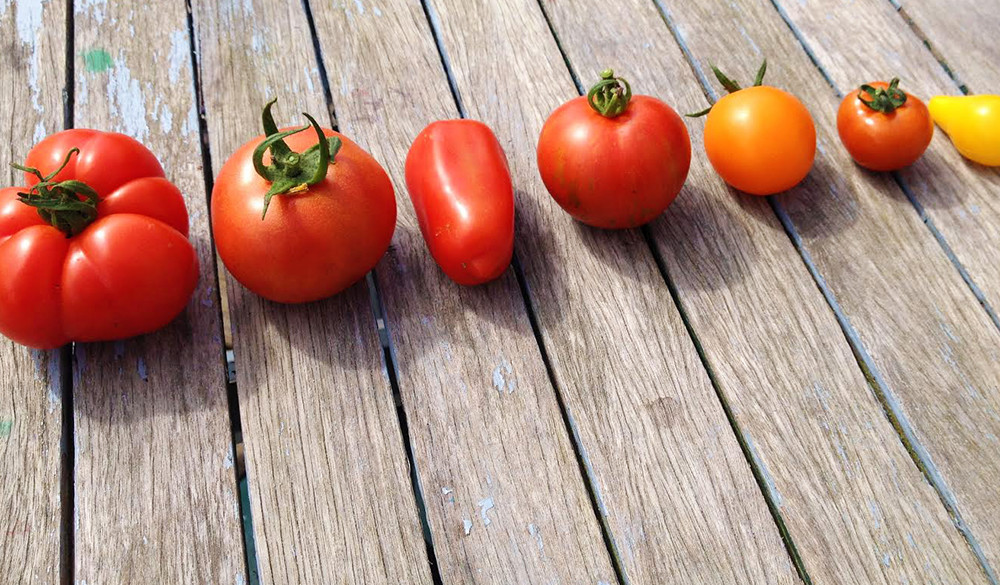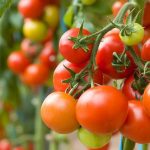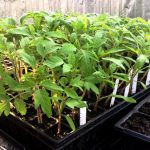Tomatoes can be difficult to grow well, but I think a proper watering regime is one of the keys to an abundant crop. The secret to watering tomatoes properly is that you need to water deep. A healthy tomato plant is a thirsty beast, supported by a deep root system—so in other words, there’s no point in standing there with the hose and spraying the plant or the soil around it with water. You need to get water right down where it’s needed at the roots. The more extensive the root system, the healthier and more productive the plant will be. There’s an added benefit to a deep watering system, in that by keeping water away from the plant itself, you minimise the chance of scorch on the leaves and avoid creating the wet conditions that could attract blight.
A few years ago I happened across a handy method of deep-watering tomatoes, which involves up-cycling used 2l milk cartons. Use a scissors to cut the base off the carton and then bury the carton, upside down, in the soil beside the plant. You can angle it slightly so that it’s aiming at the plant and bury it deep enough so that only an inch or so of the carton is visible above the soil. I generally do this when planting the tomatoes out in the polytunnel around May (so as not to disturb the plant’s roots later on). Since I have 24 tomato plants in the tunnel, it means stocking up on empty milk cartons a few months in advance. I also drop some gravel or small stones in to the bottom of the carton so that the water is slower to seep down in to the soil (otherwise it can run through the carton so quickly that it’s hard to tell how much water you’ve put in). As an aside, the cut base of the carton makes a perfect beer trap for slugs.
I water the plants early in the morning (every 2 days usually), using a lance (so there’s no stooping), simply walking up and down the polytunnel and filling each carton. I don’t have any hard science to back this assertion up, but I reckon giving each plant 2l of water regularly is the perfect amount to keep them vigorous and productive.
Things to do this June
To Do: Watering and weeding duties step up a notch—the tunnel/greenhouse in particular will require a good deal of water from now on. Watch the weather and water outside as required. Continue to earth-up potato plants to prevent the spuds becoming green. Mulch and water tomato plants and continue to remove side shoots that appear in the leaf axils. Stake everything that grows tall—raspberries, peas, beans, tomatoes etc. Net soft fruit against birds—it’s worth the effort.
Sow: Sow courgettes, pumpkins, summer and winter squash, fennel, chicory. Succession sow: beans (French and Runner), kale, pea, spinach, spinach beet, summer broccoli, carrot, swede, leek, lettuce, Brussels sprouts, beetroot, chicory, endive, turnip, kohlrabi, fennel. Plant out leeks, Brussels Sprouts, cabbage, autumn cauliflower, calabrese, sprouting broccoli, celery, celeriac, cucumbers, pumpkin, marrows, runner beans, aubergine.
Harvest: We are now really starting to see some payback from our GIYing—the first broad beans and peas as well as new potatoes, new carrots, soft fruit like gooseberries, cherries and strawberries. Herbs are in full flow. Also harvest kohlrabi, cabbage, cauliflower (month end), spinach, spring onion, shallots, salad leaves, elderflower, rhubarb, salad leaves, onions, carrots, beetroot, garlic, sea-kale.
Recipe of the Month—
Barley, Strawberry and Spinach Salad
I am a huge fan of barley, which I think is a healthy, crunchy, cheaper and generally more local alternative to the likes of quinoa and cous cous. This salad shouldn’t work on the face of it—strawberries and celery? But the dressing brings it all together. You could leave out the goats cheese if you want to keep it dairy-free. The dressing recipe is my go-to dressing for all sorts of salads—it’s simple to slap it together, so I often make twice the recipe to have it in the cupboard.
For the salad:
- 200g or 1 cup of pearl barley
- Large handful baby spinach, roughly chopped
- 1 celery stalk, finely chopped
- 1 red onion, finely chopped
- Approx 8–10 strawberries, washed and sliced
- 100g soft goat cheese, crumbled
- 50g walnuts, crumbled
For the dressing:
- 60ml extra virgin Olive Oil
- 45ml balsamic vinegar
- 2 tbsp honey
- 1 tsp grainy mustard
- ¼ tsp ground black pepper
Directions:
Put the barley in a saucepan, cover with water and cook for 30 minutes or until tender. Then drain well and transfer to a large salad bowl. Set aside to cool completely. Then add all the dry ingredients—spinach, celery, onion, strawberries, goat cheese and walnuts—and toss gently. Make the vinaigrette—combine all the ingredients in a jam jar, pop on the lid and shake well. Pour it over the salad and gently toss. Serve immediately.
School of Food, Thomastown
This year, our garden team is working with the School of Food in Thomastown in Co Kilkenny to help them with their GIY garden in the grounds of the school to supply their cookery school with fruit and veg and help students to get a better understanding of where food comes from. A very special mid-summer jazz evening on June 18th gives you an opportunity to taste some of the garden’s delights prepared by their students and served tapas style. Tickets €35 available from the School (056 7754397), or on line at SchoolOfFood.ie. The website has information on their upcoming growing and cooking courses and events, as well as their Head Gardener John Kelly’s blog.
Tip of the Month—
Tomato Watering Tips
Watering tomatoes is all about balance. Under-water and you can end up with weak plants and a poor crop. Over-water and you can end up diluting the lovely sugars in the tomatoes which give them their wonderful sweetness. Water irregularly and you can end up with split fruit. As a general rule, water only when your plants need it. Don’t get freaked out if your plants look a little wilted on a hot summer afternoon in the polytunnel or greenhouse—it’s quite normal and they generally perk up again overnight. If they look wilted in the morning however, they probably need watering straight away.
In the early stages of growth, I water every two days to encourage the root system to develop. Later on in the summer when the plants are producing fruit, I will only water every three to four days. Because of the deep watering mentioned above, the surface of the soil looks quite dry, but that’s fine—there’s plenty of water underneath for the plant to survive between watering. Deep watering also prevents waste and cuts down on the amount of water lost to evaporation in a hot polytunnel. Watering early in the day also helps.
Join GIY
By joining GIY you help us to continue the work of supporting people just like you to grow food at home, at school, in the workplace and in the community—this year we will support over 150,000 people and 4,500 community food growing groups and projects. It costs just €35 to join GIY for a year, and to say thanks we will send you a seasonal copy of our supporter’s magazine GROW and some GIY seeds for you to sow each quarter. Join today at GIYireland.com.
Michael Kelly is a freelance journalist, author and founder of GIY.
© GIY Ireland 2016—all rights reserved.




